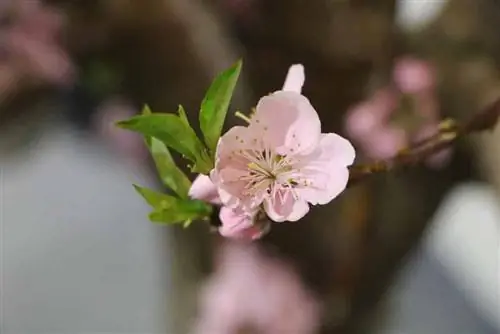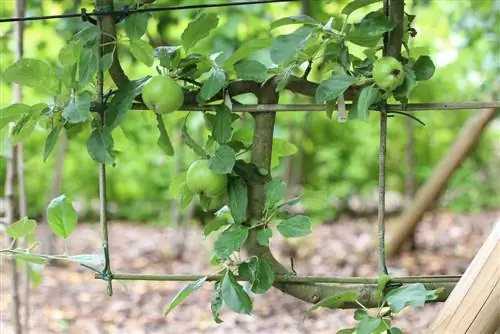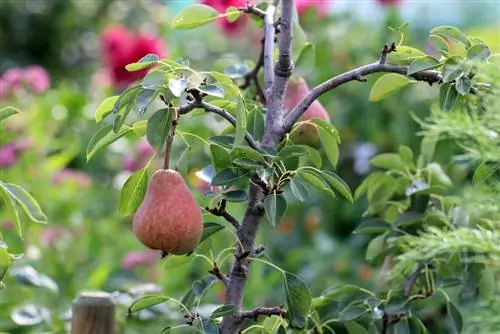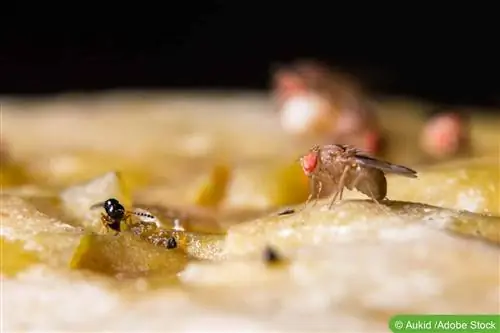- Author admin [email protected].
- Public 2023-12-17 03:39.
- Last modified 2025-01-24 12:45.
As with large fruit trees, dwarf fruit trees bloom profusely and bear more fruit if they are pruned regularly. This is especially important if, despite having little space, hobby gardeners still don't want to miss out on fresh fruit straight from the tree.
Dwarf fruit trees definition
A dwarf fruit tree is a miniature plant that differs from conventional fruit trees due to its significantly smaller size. The low growth is either caused by a special refinement or is caused by a genetic defect. As a rule, they reach a height of between one meter and 1.25 meters with a correspondingly narrower width than the larger specimens. The dwarf fruit is the same size as “real” fruit trees. However, due to the smaller dimensions of the dwarf plants, the number of fruits that grow is significantly lower. It is all the more important that cutting stimulates fruit growth in order to achieve maximum harvest results.
Dwarf fruit tree species
Almost all dwarf fruit trees are cut - from apricots and peach trees, to plum trees, to fig and cherry trees. However, the necessary cutting is limited to the trees. If you have dwarf fruit bushes or cultivate specimens with short half-trunks in pots, you should limit your cutting to topiary. All other dwarf fruit trees must be trimmed regularly according to the instructions.
Best time
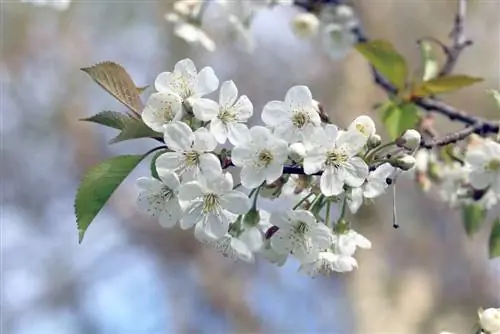
With a few exceptions, small fruit trees generally receive their first cut in spring. Typically this should be done in April or May. If the winter was relatively warm, an early start to growth must be expected. Cutting must be carried out beforehand and therefore earlier than normal. If you cut too late, there is a risk that the fruit tree will not sprout abundantly that year and will only produce a few fruits. Most miniature fruit trees can also be pruned in late autumn at the end of October/beginning of November. It is important to ensure that there is no impending frost.
Exceptions with different cutting times
- Sweet cherries: in the summer after the cherry harvest
- Apple and pear trees: late summer or early fall
- Peach trees: only in spring
Cutting reasons
Promoting the harvest
Since dwarf fruit trees can produce significantly fewer fruits than their larger “siblings”, fruit formation should be promoted as optimally as possible. This can be done by cutting annually. Shortening the shoots stimulates fruit formation. Thinning out allows more air and light to reach even hidden branches. By cutting off old, dried branches, the plant does not use up nutrients unnecessarily and can use them to produce fruit. In addition, the shoots are strengthened during growth, which results in better fruit quality.
Protection against fungal diseases
If the crown and the internal branches become too dense, moisture is retained for a long time because neither air nor sun can help it dry out. A fungus can quickly form from this. Depending on the type of mushroom, the flowers do not bloom, fewer fruits are formed and the quality of these leaves something to be desired. In many cases, a fungal infection can also lead to the death of the plant. Shortening the crown as well as thinning out the inner branch area helps as a preventative measure.
Avoid trouble with your neighbors
If the dwarf fruit tree in the garden bed gets out of shape, fruit-covered branches can quickly protrude over the fence into the neighbor's property. It's annoying when they claim the fruits that are usually only available in small quantities or complain about falling leaves on their property in the fall. To avoid this, always check in spring that there is enough distance between dwarf fruit trees and neighboring properties and shorten branches if necessary.
Keep in shape
Many dwarf fruit trees are offered in columnar form or as half trunks. In order to maintain their decorative shape for years, regular trimming is essential. If no topiary is done, the dwarf trees often lose their shape completely in the second year, while in the first year they “just” appear unkempt. If you intentionally want to let your dwarf fruit tree get out of shape, you have to expect a reduction in flowers and fruit.
More stable trunks
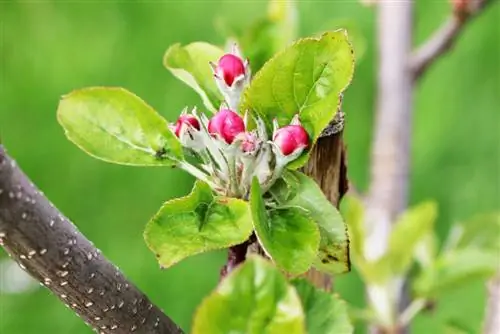
The small fruit trees often have thin trunks. There is a trick to grow thicker trunks: simply cut the wood/bark on the trunk slightly. To do this, scratches about four to five centimeters long are made with a sharp knife in an oblique or parallel line to the trunk. The cut should reach deep into greens. In this way a wound is created, but this stimulates the growth substances, which then primarily feed the trunk and thus create more trunk circumference.
Thicker shoots
Fruit cannot usually ripen to the end on thin shoots because it becomes too heavy for the thin branches and they often break off/kink. Thin shoots become thicker by not cutting them. They get their girth from the upper bud tips. From there the thickness forms downwards. If you cut this off, the shoot remains thin. If you don't cut it, you'll have to be patient until the thickness increases towards the bottom. If fruit ripens, it is advisable to remove it in good time before the thin branch breaks. This may not be a problem with cherries or similarly light fruits, but lemons, apples or pears usually cannot withstand a thin shoot.
Less but better fruit
In order to improve the quality of the fruit, so-called fruit thinning should be carried out. This is recommended if too many fruits have to share the space. In this way, they also share the nutrients that arrive there and do not develop optimally. Separating the fruits means removing some fruits so that the remaining ones are supplied with more nutrients and ripen better. Fruit thinning is usually carried out at least four weeks before the harvest level is reached.
Cutting dwarf fruit
For he alth and lush growth, normal rejuvenation pruning is required, which should be done every year. The basis for the optimal cut is a few basic rules, followed by the cutting technique and cutting lengths.
Basic rule
- Branches/shoots should not cross each other or run parallel
- They should not grow inwards, steeply upwards or downwards
- Branches always point away from the trunk
- Leave side branches for more flower formation
Editing technique
- Short fresh shoots by a maximum of one or two buds
- It is generally cut off directly above a remaining bud
- Remove old and dried branches from the trunk
- Short diseased plant parts at least to the he althy area
Root cutting
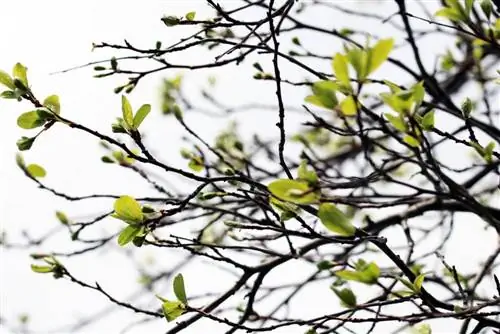
A root cut should be carried out when a dwarf fruit tree is cultivated or repotted in order to optimally adapt it to the size of the container. The rule here is that the roots have at least three to five centimeters of space up to the wall of the pot. If this is not the case, the roots must be cut. It should be noted that a root cut always affects the crown design. This means that if you cut off thick, strong roots, the branches/shoots grow thin and can appear more delicate in their structure.
Mistakes to avoid
Cut too early or too late
No matter whether you are pruning in autumn or spring, if frosty temperatures appear immediately after pruning, your dwarf fruit tree is at risk of suffering from frostbite. Always keep an eye on the weather forecast when cutting your specimen.
Water bullets
Shoots that grow steeply upwards are called water shoots. They are often relatively thick. Some believe that these shoots can give dwarf fruit trees more stability and leaf density. The opposite is the case, because water bullets compact the inner branches, less light gets in, leaf growth decreases and light spots increase. In addition, water bullets are more susceptible to fungal diseases. For these reasons, water bullets should always be removed.
Tip:
If you tear out water bullets, new ones will not recreate as quickly as they would if you cut them off.
Summer cuts
Dwarf fruits that are pruned in the summer after the harvest should not be pruned too early. If the winter and spring were warmer, fruit ripening may occur more quickly than normal. Therefore, the cut should not be done earlier, as in some cases this can lead to renewed sprouting. Until winter/frost begins, the branches would not be robust enough to survive the cold season unscathed. For this reason, summer cuts are generally only recommended in August.
Minor cutting
Avoid being too “delicate” when cutting. When it comes to dwarf fruit trees, more is better than too little. If you cut too little, this is equivalent to missing an annual cut. It will not have any positive effects on your plant. Growth will not be stimulated, nutrient supply will not be optimized and crop selection will increasingly decline. A third of the shoots should be cut off every year. Exceptions here are branches with a maximum of buds when pruned in spring.
cuts
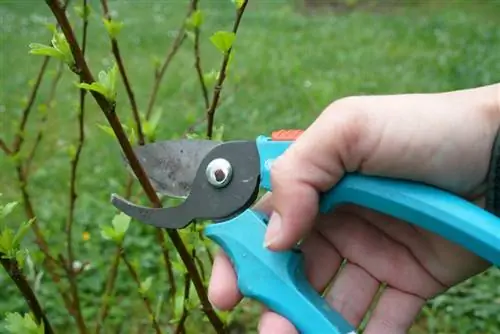
Using unsuitable and/or unsharp cutting tools often leads to injuries and bruising at the desired interfaces. Bruising restricts the supply of nutrients to the area above. In most cases, the affected branches die within a very short time.
If shoots are only scratched by an unsharp cutting tool, there is an open wound. As a rule, a he althy dwarf fruit tree can cope with this if it involves one or two shoots. However, if pruning occurs at the same time, the risk of a fungal infection increases. Injuries provide optimal conditions for fungi to get inside the plant. Suitable cutting tools include:
- rose scissors
- Small pruning shears
- Pinching scissors for thicker shoots/branches
- Sharp knife with slight serrations for thinner shoots/branches
Saplings
If you discover a sapling at the base of the trunk, you can use it for propagation. You should do this quickly or at least remove the sapling quickly, as it negatively affects the growth of your dwarf tree and can reduce flower and fruit production.
Garden shears as an all-round tool
Garden shears and especially rose shears can be used in a variety of ways in the garden or for balcony planting. You can quickly grab the all-round tool and use it to cut from plant to plant and from branch to branch. This can have fatal consequences, and not just for your dwarf fruit tree. Garden tools should always be disinfected every time you work on a plant, as they can transmit diseases and pests without you noticing. Therefore: always use disinfected cutting tools on dwarf fruit trees.

